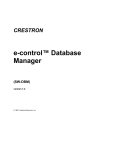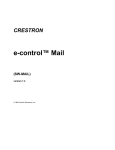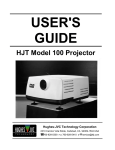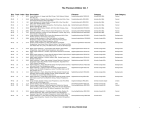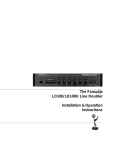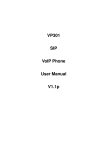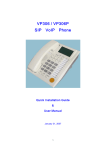Download AMX AXC-232 Plus plus Operating instructions
Transcript
“Perfecting Video with a No-Compromise Approach for Reproducing the Ultimate Film Experience” The Faroudja VP301 Video Processor With Picture Plus™ Technology Installation & Operation Instructions ª TABLE OF CONTENTS History . . . . . . . . . . . . . . . . . . . . . . . . . . . . . . . . . . . . . . . . . . . . . . . . . . . . 2 Licensees and Awards . . . . . . . . . . . . . . . . . . . . . . . . . . . . . . . . . . . . . . . . 3 System Description . . . . . . . . . . . . . . . . . . . . . . . . . . . . . . . . . . . . . . . . . . 4 Inventory List . . . . . . . . . . . . . . . . . . . . . . . . . . . . . . . . . . . . . . . . . . . . . . . 5 Caution Notes . . . . . . . . . . . . . . . . . . . . . . . . . . . . . . . . . . . . . . . . . . . . . . 5 Technical Highlights . . . . . . . . . . . . . . . . . . . . . . . . . . . . . . . . . . . . . . . . . . 6 Installation Instructions. . . . . . . . . . . . . . . . . . . . . . . . . . . . . . . . . . . . . . . . 8 Rear Panel I/O . . . . . . . . . . . . . . . . . . . . . . . . . . . . . . . . . . . . . . . . . . . 8 Interface . . . . . . . . . . . . . . . . . . . . . . . . . . . . . . . . . . . . . . . . . . . . . . . . 9 Operating Instructions . . . . . . . . . . . . . . . . . . . . . . . . . . . . . . . . . . . . . . . 10 Troubleshooting . . . . . . . . . . . . . . . . . . . . . . . . . . . . . . . . . . . . . . . . . . . . 12 Appendix A: Remote Control Operation. . . . . . . . . . . . . . . . . . . . . . . . . . 13 Specifications . . . . . . . . . . . . . . . . . . . . . . . . . . . . . . . . . . . . . . . . . . . . . . 16 Copyright©1998 by Faroudja Laboratories, Inc. No part of this document may be copied, photocopied, reproduced, translated, or reproduced by any electronic medium or machine readable form without prior consent, in writing, from Faroudja Laboratories, Inc. The Faroudja Laboratories VP301 Line Multiplier is covered by the following United States patents: 4,030,121, 4,179,705, 4,240,105, 4,262,304, 4,847, 681, 4,864,389, 4,876,596, 4,893,176, 4,916,526, 4,967,271, 4,982,280, 4,989,090, 5,014,119, 5,025,312, 5,159,451, 5,237,414. All Rights Reserved. HISTORY Some Video History and the Faroudja Approach Faroudja Laboratories, located in northern CaliforniaÕs Silicon Valley, was founded in 1971 by Yves and Isabell Faroudja to develop state-of-the-art video processing technology. Over the last 26 years, Faroudja Laboratories has developed hundreds of advanced electronic processes to improve video enhancement, noise reduction and NTSC encoding/ decoding technologies. Many of these processes are used under license by the worldÕs leading electronics companies in a wide range of high performance video products. Faroudja professional video equipment is also currently hard at work in hundreds of television studios. Thus Faroudja technology is utilized and enjoyed in millions of American homes every day. motion pictures. In pursuit of this goal, Faroudja Laboratories has made use of techniques from Faroudja professional video equipment and incorporated these in the VP201/VP251 line doublers, VP401/VP401U Line Quadruplers and now the VP301. FaroudjaÕs unique approach focuses on critical problem areas in the NTSC and PAL broadcast format. With patented engineering and design work, Yves and Faroudja Laboratories have created an exceptional product that brings new levels of visual reality to the enjoyment of discerning video enthusiasts around the world. This booklet will provide the reader with a handson look at the VP301, its operation and benefits. Also supplied is an overview of the proprietary technologies utilized in this extraordinary device and an explanation of the visual improvements it provides in home video and corporate playback systems. Yves Faroudja has devoted his career and his company to the goal of enabling home video systems to achieve the image quality of 35mm 2 LICENSEES AND AWARDS On June 24, 1998 Yves Faroudja was awarded the prestigious Charles F. Jenkins Lifetime Achievement Award from the Academy of Television Arts & Sciences for his video processing technology. Faroudja’s first Emmy was awarded in 1991. Some of this award winning technology is used in the VS50. 1987: SMPTE DAVID SARNOFF GOLD MEDAL AWARD for ÒContributing to Optimizing NTSC PerformancesÓ Licensees Around the World FaroudjaÕs inventive approach to improving the quality of video imaging has caught the eye of some of the worldÕs greatest high technology companies. The following list represents those that have recognized the value of FaroudjaÕs solutions to imaging problems and pay for the opportunity to incorporate this technology in their advanced video products (as of January 1998): Canon Conrac General Instrument Grass Valley Hitachi Ikegami JVC Matsushita (Panasonic) 1988: MONITOR AWARD for ÒExcellence in Engineering NTSC Encoders and DecodersÓ 1989: BM/E AWARD for ÒExcellence in EngineeringÓ Microtime Mitsubishi NAC NEC Sanyo Sharp Sony S3 Toshiba 1991: Technology Executive of the Year from Cable TV Business 1991: EMMY from The National Academy of Television Arts and Sciences for ÒTechniques for Minimization of NTSC Artifacts Through Advanced Encoding TechniquesÓ 1992: VIDEO GRAND PRIX AWARD Audio/Video International LD100 Line Doubler ÒAdvanced Technology AwardÓ Awards and Achievements Yves Faroudja and Faroudja Laboratories have garnered worldwide recognition and a number of industry awards. These honors are notable for several reasons. They are in response to the significant impact that FaroudjaÕs technology has made on the serious improvement of video quality. They are also a reflection of his long term dedication to continually improving and optimizing the performance of the NTSC and PAL video formats. 1993: VIDEO MAGAZINE Video Visionary 1995: BROADCAST ENGINEERING AWARD 1997: VISUAL GRAND PRIX AWARD Audio Video Review Magazine (Japan) LD200 1997/1998: RECOMMENDED COMPONENTS Stereophile Guide to Home Theater Magazine AAA Rating: VP250, VP400A 1998: PLATINUM AWARD AV Video Multimedia Producer Magazine Outstanding Achievement: VP250 3 SYSTEM DESCRIPTION 75-Ohm terminator switch is provided and should be in the ON position if the input loop is not used. The S-Video input uses a standard 4-pin connector. This input is not available for a looped operation and is terminated internally. The RGB and Component inputs use BNC connectors. As with the video input, these inputs can be looped to other devices. Selectable 75-Ohm terminations are provided. If the looped inputs are used, these cables should be kept short (under 6' in length) or a video distribution amplifier should be used. This allows the VP301 to keep the highest signal bandwidth possible without having the high frequencies being attenuated in a long cable. The Faroudja VP301 Line Multiplier is a precision video instrument used to convert NTSC interlaced signals into 600 visible, progressively scanned lines (800X600 resolution). Using Picture Plusª technology, the VP301 removes typical video processing artifacts while also increasing color purity and image detail, closely matching 35mm film. The VP301 is designed as an ideal match for Graphics-Grade 7Ó and 8Ó CRT projectors that require a faster processor than the Faroudja Line Doublers but cannot handle the performance demands of Line Quadruplers. It is also an ideal match for three-chip DLP projectors that require the 800X600 resolution. Output from the VP301 is provided by six BNC connectors as well as one 15 pin ÔDÕ connector. The BNC outputs provided are Red, Green, Blue, Horizontal Sync, Vertical Sync and Composite Sync. Interface to monitors/projectors can be a 4 or 5 wire connection. The VP301 is capable of driving a monitor/projector using the BNC outputs as well as a 15 pin ÔDÕ connector, at the same time. The monitor and projector must be compatible with a 40KHz Horizontal scan rate. Front panel features include Power, Input Select, Brightness, Contrast, Color, Auto-Tint, Noise Reduction, Detail, Digital Filter and Freeze. All of the settings are automatically stored when the unit is turned off. Also, up to 16 custom presets can be set. All front panel features can be adjusted by infrared and RS232 remote control. Inputs include: Composite Video, S-Video, RGB and Component. The Video input may be connected by either a BNC connection or a video RCA type connection. These inputs are looped internally so that other devices may use the signal. A selectable 4 SYSTEM DESCRIPTION Circuit Description When using the RGB or Component inputs, Sync is derived from the G or Y input signals unless sync is provided to the Composite Sync input. The Composite Sync input will override the sync from the G or Y inputs. The sync signal then feeds the VP301 clock generator and is used as a reference to generate Horizontal Sync, Vertical Sync and Composite Sync. Figure 1 is a block diagram of the VP301 showing signal flow and the location of front panel controls and switches. Composite Video and S-Video inputs are connected to the decoder with AGC control and converted to Y, R-Y and B-Y signals. The Y, (Luminance) output from the decoder enters the input switcher while the R-Y and B-Y signal enter the Chroma Enhancement block where the Tint phase can be adjusted when selected in the manual mode. The RGB input signals are transcoded to Y, R-Y, and B-Y signals and fed to the input switcher. Component signals are fed directly to the input switcher. Inventory List 1 VP301 Digital Video Processor 1 Installation/Operation Manual 1 Warranty Card 1 Power Cord The input switcher then selects the correct function and outputs the Y signal to the Luminance Line Multiplier block. The Luminance Line Multiplier block contains the Brightness, Contrast and Freeze controls while the R-Y and B-Y signals enter the Chroma block where the color level can be controlled along with the Freeze controls. The Line Multiplier Luminance signal now enters the Luminance Detail and Noise Reduction block where the functions of Noise Reduction and Detail Level are controlled. Caution Notes Do not connect the VP301 to a Monitor/ Projector not capable of the correct scan rates. (40KHz) The Luminance signal from the Luminance Detail and Noise Reduction block along with the R-Y and B-Y signals from the Chroma Line Multiplier block feed the output transcoder and are converted to RGB signals. These RGB signals are buffered and then sent to both the BNC and monitor output connectors. High Voltages are present inside. Opening the unit will void all warranties. No user serviceable parts inside. 5 TECHNICAL HIGHLIGHTS Picture Plus™ Technology Ð The VP301 is called a Line Multiplier. However, just increasing the number of lines can make the image worse. This is where Picture Plusª technology becomes critical. Picture Plus represents a complex, multi-stage process that takes advantage of all the patented Faroudja circuitry for color, motion and detail processing. How these circuits improve the picture are outlined below. R G B VIDEO IN Y/C IN Y R-Y B-Y Y A DECODER B R-Y B-Y R OUT Y R-Y LINE QUADUPLER B-Y C BANDWIDTH EXPANDER G OUT B OUT SYNC OUT VGA OUT MONITOR VP301 BLOCK BLOCK DIAGRAM DIAGRAM VP400 DOT CRAWL and HANGING DOTS Ð This phenomenon is easily seen with large, highly colored, stationary graphics like titles and credits. Dot crawl is a rapid upwards movement of colored dots on sharp vertical transitions. Hanging dots lie underneath all the colored horizontal transitions. Both of these color aberrations are artifacts that appear due to an imperfect color decoding process. The VP301 has an adaptive comb filter that eliminates both of these distortions. The impact is color transitions that are clear, sharp and natural. STAGE A COLOR PROCESSING: Chroma Bandwidth Expansion + Adaptive Comb Filter + Cross-Color Suppression COLOR BLURRING Ð The engineers of the 1940Õs (and the 1950Õs, before and during the development of color broadcasting), had no idea that video images would one day be blown up as large as they are today. They therefore designed the color section of the NTSC standard with severe bandwidth restrictions. This causes colors in various video images to ÒblurÓ and ÒsmearÓ. These effects are further aggravated by storage media such as VHS tapes, that further degrade the chroma or color signal. e.g. Ð note how deep reds smear on VHS tape images. STAGE B LINE PROCESSING: Film/Video Motion Tracking The Faroudja VP301 utilizes proprietary circuitry to recreate and further correct color details. Technically, this is accomplished by making use of the sharper black and white transitions to develop a correction signal that is then used to sharpen the color transitions. The result is colors that are restored with sharp details and video images that retain their original crisp look. THE VP301 Patented Line Multiplier: eliminates VISIBLE SCAN LINES Ð The secret of the VP301Õs uncanny ability to increase the lines of information without adding digital artifacts is in its unique ability to detect motion and interpolate correctly. The Faroudja VP301 does this thanks to its proprietary, patented circuitry. It can detect the difference between a film image that has been transferred to video or video image that emanated from a video camera. After detecting the image type, the VP301 adjusts its algorithm to compensate accordingly. RAINBOW PATTERNS Ð When you notice the fine detail of a striped referees shirt rippling with colored rainbows as the camera pans by, youÕve seen video cross-color interference. This is critical because todayÕs home theaters are primarily used to show films that were transferred to video whether on tape, laserdisc or off the air (virtually all prime time programs are film transferred to video). The VP301 offers sharper, uniquely clean, artifact-free filmlike images without visible scanning lines. This annoying artifact is caused by imperfect separation of the color (chroma) and black and white (luminance) signals, by the color decoder circuitry. Simple techniques used commonly to separate the two signals can be effective most of the time but occasionally are fooled by finer pitch detail areas like the refereeÕs shirt. The VP301 has patented cross color suppression that eliminates decoding errors of this type and enables the reproduction of sharper, cleaner color images. Again, historically speaking, electrical engineers in the 1940Õs knew the resolution of a picture tube was dependent on two different mechanisms. Horizontal resolution is a function of bandwidth (frequency response) of the 6 Y/ C RGB SYNC B-Y Y R-Y LASERDISC PLAYER VIDEO SWITCHER VIDEO TUNER R COMPOSITE VIDEO G VP301 VIDEO PROCESSOR B SYNC MONITOR VIDEO PROJECTOR OR MONITOR WITH 7''or 8'' CRT TUBES COMPUTER DISPLAY VCR TYPICAL VP301 UTILIZATION TYPICAL VP301SYSTEM SYSTEM UTILIZATION circuitry, while vertical resolution is a function of the scanning frequency (the number of scan lines in each picture). Given these mechanisms and with an average size picture tube of 8-10Ó, they designed the 525 line broadcast standard so that viewers would not see the scan lines when watching TV. They had no idea that someday people would be projecting home theater video images with diagonal screen sizes of 10Õ and more. sources however, such as VHS tapes (230 lines), are clearly deficient. The problem is compounded when the scan lines are doubled along with other signal processing. The lack of high frequency detail becomes very obvious when the more common sources are used. The resultant picture is free of scan lines but dull, with a serious loss of definition. The solution is to expand the high frequencies without producing annoying and picture degrading artifacts. Based on those NTSC parameters, using a 10 ft. diagonal screen would require the viewer to be located more than 45 ft. from the screen to see the picture as it was intended without scan lines! Unfortunately, todayÕs large screen installations have scan lines that are quite visible, especially with some of the latest high resolution monitors and projection televisions. The VP301 eliminates this problem by scan multiplying the 525 interlaced lines (only 480 lines are actually visible) to become 600 progressively scanned lines. The result is the elimination of visible scan lines and increased brightness and detail. The image produced by the VP301 is virtually film-like in detail, motion and color. The bandwidth expansion circuitry in the VP301 is exceptionally sophisticated, using FaroudjaÕs double differentiation techniques to sharpen the edges of both horizontal and vertical details. The result is a sharply detailed image that appears crisp and three dimensional with no visible negative side-effects. This process can effectively double the perceived bandwidth and therefore the resolution of the incoming signal. FAROUDJA VP301 APPLICATIONS Ð While the technical accomplishments of the VP301 represent years of intense research and development, its use is straightforward and direct. The block diagram (above) illustrates a typical home theater system configuration and shows how the VP301 would be inserted in the signal path. Many entertainment sources benefit greatly by the VP301Õs unique attributes; laserdisc, VHS video, SVHS, DVD, cable TV, broadcast TV, etc. The VP301 has proven to be an invaluable tool in other presentation disciplines where image quality is important; computer data displays, professional installations in boardrooms and media rooms, military installations, government agencies and academic uses in schools and colleges. From the quality of its individual parts to its state-of-the-art patented circuitry, the VP301 is truly in a class by itself. STAGE C DETAIL PROCESSING: Luminance Bandwidth Expansion There is a major limitation with most contemporary program sources Ñ lack of frequency response. The best video sources such as satellite dish reception and laserdiscs can provide acceptable resolution (400 plus lines of horizontal resolution). Other more common 7 INSTALLATION INSTRUCTIONS Figure 2 Unpacking Rear Panel I/O Remove the VP301 from the shipping container and examine it for any signs of shipping damage or missing items, (check inventory list on page 5). 11. Video Termination Switch Ð Select ON when not looping the Video signal to other video devices, (75 Ohm). All shipping materials should be saved if the unit is to be moved or should need to be returned for service or repair. 12. Video Input (BNC) Ð Composite Video Input 13. Video Input (RCA) Ð Composite Video Input Installation 14. Video Input (BNC) Ð Composite Video Input Loop The VP301 is designed to be placed on a table or rack mounted. If the rack mounting installation kit is to be used, the rack mount ears are installed by removing the 4 screws retaining the side panels and installing the rack mount ears using the 4 screws. Remove the four feet from the unit. When installing in a rack, it will be necessary to support the unit by using rack support rails supplied by the rack manufacturer. 15. S-Video Input (4 Pin) Ð input internally terminated. 16. R/R-Y Termination Switch Ð Select ON when not looping the R/V signal to other video devices (75 Ohm). 17. R/R-Y Input Loop (BNC) Ð Red/R-Y Input 18. R/R-Y Input (BNC) Ð Red/R-Y Input Do not support the unit by the rack mount ears alone! 19. G/Y Termination Switch Ð Select ON when not looping the G/Y signal to other video devices (75 Ohm). Contact Faroudja to order rack kits. 10. G/Y Input Loop (BNC) Ð Green/Y Input Ventilation 11. G/Y Input (BNC) Ð Green/Y Input The VP301 will require that air flows freely through both the bottom and top vent holes. Blocking these holes will greatly reduce the reliability of the unit and lead to the possibility of overheating. 12. B/B-Y Termination Switch Ð Select ON when not looping the B/B-Y signal to other video devices (75 Ohm). 13. B/B-Y Input Loop (BNC) Ð Blue/B-Y Input When the unit is rack mounted, a minimum of 1.25" (1 rack unit height) of free space is to be provided for both the top and bottom of the unit to allow for proper cooling. It is also recommended that the rack be forced air cooled. 14. B/B-Y Input (BNC) Ð Blue/B-Y Input 15. Sync Termination Switch Ð Select ON when not looping the Composite Sync signal to other video devices (75 Ohm). 8 Figure 3 Interface Figure 3 outlines the installation of the VP301 using inputs from: 16. Sync Input Loop (BNC) Ð Composite Sync Input Loop 17. Sync Input (BNC) Ð Composite Sync Input 1. A composite source such as a DVD Laser Disk Player, VCR or TV Receiver. 18. Red Output (BNC) Ð Red Output 714mV 2. An S-Video input such as a S-VHS VCR or DVD 19. Green Output (BNC) Ð Green Output 714mV 3. An RGB input with sync on green or a Component input such as a DVD player, Camera or Beta-SP recorder with sync on Y. If sync on green or sync on Y is not available then Sync can be interfaced using the Composite sync input. 20. Blue Output (BNC) Ð Blue Output 714mV 21. Horiz. Sync Output (BNC) Ð Horizontal Sync Output Ð4Vp-p, 40KHz 22. Vert. Sync Output (BNC) Ð Vertical Sync Output Ð4Vp-p, 59.49Hz All inputs with the exception of the S-Video input have selectable 75 Ohm input termination switches. These switches are to be in the ON position unless the unit is being used in a looped configuration. Termination is then located at the last unit in the loop. 23. Sync Output (BNC) Ð Composite Sync Output Ð4 Vpp 24. Monitor Interface Output Ð Positive TTL Sync Levels. See appendix B for pinout information. Note: The diagram shows a 5 wire connection to the monitor/projector, i.e. Red, Green, Blue, Horizontal Sync and Vertical Sync. For monitors/ projectors with a 4 wire input, use Red, Green, Blue and Composite Sync outputs. 25. Remote Control Interface Ð See appendix A for interface diagrams. 26. Power Input Ð 100-250 VAC, 50/60Hz, 60W The monitor/projector will be terminated at 75 Ohm either internally or by switches located on the monitor/projector. 9 VIDEO PROCESSOR OPERATING INSTRUCTIONS 17 13 12 1 14 15 2 3 4 5 16 6 PICTURE CONTROLS 7 8 9 11 10 18 button is touched or when the OSD times off (after approx. 10 seconds). The front panel offers complete controls of key picture adjustment parameters: Brightness, Contrast, Tint, Color, Noise Reduction, and Detail. Select the different presets by pressing the Preset button on the remote. To adjust the different controls simply press the button associated with the parameter to be adjusted and toggle the value key up or down (see figure 5). The LCD readout on the front panel provides a status report with both numbers and a bar graph for setting levels. The VP301 Control panel Selecting a push button control lights the adjacent LED to indicate activation or selection of that particular function. 1) Power ON/OFF Ð Press the button and the LED lights green to indicate POWER ON. When the VP301 powers up it is automatically set to operate just as it was when it was last turned off. Presets Ð Once the levels have been adjusted for the best image they can be stored as one of four presets. There are four present for each input source, i.e. four for Video, Four for S-Video, etc. 1) Power ON/OFF Ð Another push on the switch and the power is cut off extinguishing the green LED. The Freeze Circuit is automatically disengaged, if in use, upon turn off. To store, first adjust the image then press the Store button. The next preset button pushed will store those settings. The preset will automatically be recalled the next time that input source is selected. INPUT SELECTION SWITCHES The Factor Preset button recalls all settings to SMPTE reference standards. When aligning the projector for the first time, the VP301 should be in the factory preset. Using an external test pattern from a DVD, laserdisc, or pattern generator adjust the brightness and contrast using the projectorÕs controls. Then adjust Color, Tint, and Detail using the controls on the VP301. Once completed, store the settings in one of the presets. Press to Select 2) Video Ð refers to any composite NTSC video signal (e.g. VCRÕs, laserdisc players, cable boxes, etc.) 3) S Video Ð refers to any source that outputs S-Video signals (DVD, S-VHS, satellite receivers, etc.). Using the input allows one to realize all the benefits of maintaining the separation of the luminance (picture) and chrominance (color) signal through the video signal processing chain, thus avoiding rainbow patterns and dot crawl. To store presets using the On-Screen-Display (OSD) with the infrared remote, first adjust the setting for the best image possible, then use the function key to scroll down to the Preset function. Use the value key to select which preset to store the information. The information will be stored either when the function 4) RGB Ð refers to the incoming video signal broken down to the individual red, green and blue format more typically found in the professional and broadcast area. 10 5) Component Input Ð refers to the video signal in its component form (Y, R-Y, B-Y or Y, Cr, Cb for DVD) carried in a 3-wire cable. 6) Brightness Ð The Brightness control adjusts the black levels in the image. The level should be adjusted so that the color black is achieved (not gray) yet faint details should still be observable in the shadows. It is best to use a test pattern known as a PLUGE to set the levels. The adjustment levels can also be seen on the projection screen for easy adjustment. 7) Contrast Ð This control adjusts the level of white in the image. Using a well-lit image, adjust the contrast for the brightest image but not so bright that white areas start to turn green or cause blooming. Blooming is seen as bright areas of the picture smearing off to the left. It is best to use a test pattern known as PLUGE to set the levels. F Contrast 8) Color Ð This adjusts the amount of color in the image. Adjust to individual taste. The VP301 has an AGC (Automatic Gain Control) that adjusts the color level automatically to maintain optimum color settings using the customerÕs adjusted setting as a reference. It is best to use a test pattern known as SMPTE color bars with a blue filter to properly set the levels. Step 1 Press Control F Step 2 Adjust Level Figure 4 14) Store Ð Press this button to activate the store function. The next preset pressed will store the current settings. 9) Tint Ð This adjusts the color phase seen as the range from green to magenta. The VP301 has an APC (Automatic Phase Control) that maintains proper phase. This setting is best left in the preset position. It is best to use a test pattern known as SMPTE color bars with a blue filter to properly set the levels. 15) Factory Ð The Factory Presets are set to broadcast industry standards. And can be used as a reference or to reset levels if they get misaligned. 16) Preset Ð This control stores all picture adjustments in a nonvolatile memory. There is a separate bank of four presets for each input, that are automatically recalled when the input is selected. 10) Noise Reduction Ð This adjusts the visibility of small edge details such as film grain and dust. Lowering the level increases the visibility of this type of noise. Increasing the level helps to filter them out. For most sources, this should be left in the preset setting. 17) IR Window Ð Receives the information from the remote control. Do not block this sensor. 18) Value Adjust Ð This rocker switch adjusts the value of each function. Pressing the top portion increases the level, pressing the bottom portion reduces the level. 11) Detail Ð This control adjusts the amount of large edge details such as black to white transitions. The level should be set where there is the maximum amount of edge detail without excessive ÒringingÓ and harshness. For most sources, this should be left in the preset setting. DETAIL CONTROLS The VP301 offers two controls for enhancement, Noise Reduction and Detail. The two controls work together to provide optimum picture detail without introducing ÒringingÓ artifacts for both horizontal and vertical edges. This is very helpful with low quality sources such as VHS tapes. Also, even high quality sources such as DVDs and Laserdiscs can have excessive detail enhancement recorded in the movie this can be seen as white halos along dark edges. The detail controls can be reduced, to limit the visibility of the halos. 12) Digital Filter Ð This control eliminates edge breakup caused by poor quality compression on some satellite channels. It should never be used with higher quality sources such as DVDs, laserdiscs, and high quality satellite channels. 13) Freeze Ð This control captures a video frame for a high-resolution still image. Pressing the button again unfreezes the image. (Note: the freeze function must capture both video fields for a clean image. Using the freeze on a fast moving image may create a lined image, a result of only a partial video frame capture. Refreezing the image should yield smooth results.) However, for the most part, the settings should be left in the preset setting. If the detail level must be turned way up to see details, there is a good chance there are other factors involved, such as the projector becoming out of focus or poor cable quality. Contact the dealer for assistance. 11 TROUBLESHOOTING Problem Solution No power light Unit not turned on Unit not plugged in Fuse blown No power at plug No picture Video source not selected No video source connected or operating Projector/Monitor not turned on Projector/Monitor not connected correctly Bad video cable Unit in freeze mode Check brightness and contrast levels Colors bleeding Check termination Check projector/monitor termination Contrast set too high Color set too high Picture not stable Check interface cables Sync cables are swapped or not connected Input source not selected correctly Check input terminations Projector Fast/Slow Horizontal time constant. Should be set to fast. Incorrect colors Tint in manual mode Defective output cable RGB cables are swapped Check projector/monitor termination Input source not selected correctly No burst on input RGB or Y,R-Y, B-Y Inputs not terminated. Picture washed out Composite input not terminated NOTE: To make sure that an input source is not the cause of a problem for a composite source, turn the termination switch off and connect a composite monitor to the composite input Loop input. For a R,G,B input source, turn the three termination switches off and connect a R,G,B monitor to the R,G,B input Loop input. To make sure that a projector is not the cause of a problem, connect a 40KHz multisync monitor to the 15pin output connector and check the display to see if it is correct or if the monitor display shows the same problem as the projector display, then the VP301 has a problem and you should contact our Technical Support Department. 12 APPENDIX A VP301 Remote Control Operation CABLE SPECIFICATION: Computer Interface Overview Remote control of the VP301 Line Multiplier is provided by an RS-232 serial interface connector located on the rear panel of the unit. A external controller such as a computer or integrated system controller with an RS-232 interface may be used to control all user accessible functions of the Video Processor. VP301 Video Processor DATA TERMINAL or IBM PC DB25 (MALE) DB25 (FEMALE) RxD 2 20 TxD TxD 3 30 RxD GROUND 7 RS-232 controllable functions include: Video, S-Video, RGB, Component (YUV), Brightness, Contrast, Color, Tint, Noise Reduction, Detail Level, Auto-Tint, Digital Filter On/Off, Freeze On/Off, Echo On/Off, Help, Status and Return to Factory Preset. 70 GROUND 40 RTS 50 CTS 60 DSR 20 DTR CABLE SPECIFICATION: AMX AXC-232 Interface Communication Settings VP301 Video Processor Communication with the VP301 Video Processor is accomplished by setting the following conditions: 9600, No Parity, 8 Data Bits and 1 Stop Bit. The factory BUAD rate is set at 9600 but rates of 1200, 2400 and 4800 are also available. AMX AXC-232 INTERFACE DB25 (MALE) RxD 2 3 TxD TxD 3 2 RxD GROUND 7 Baud Rate Selection 1 GROUND CABLE SPECIFICATION: CRESTRON CNCOMH-2/CNMS Interface To change the RS-232 BAUD rate, remove the top cover of the VP301 Video Processor. A 4 switch Dip switch is located on the front panel. Set the switches from the table shown below. If the BAUD rate is changed, the VP301 MUST be powered off and then on for the new BAUD rate to take effect. VP301 2 Video Processor CRESTRON CNCOMHINTERFACE DB25 (MALE) INSTALLATION Interface to the Processor is done by using a 3 wire interface. Interface schematics for the IBMPCª, AMXª and CRESTRONª controllers are shown to the right. RxD 2 3 TxD TxD 3 2 RxD GROUND 7 13 5 GROUND APPENDIX A Programming the VP301 Variable Adjustment Commands: Command Line The VP301 is programmed by means of a ÒCommand LineÓ, which is an ASCII string of up to 255 characters that contains one or more individual instructions. The Command Line offers the best compromise between manual operation via a data terminal and automatic control via a controller. Command Line Entry A Command Line can be entered in either upper or lower case by means of a data terminal or other controller. The Echo Mode determines the response of the VP301 to the incoming data stream. If the Echo Mode is ON (E1 command), the entered characters are echoed back to the host and any message is sent in its entirety. IF Echo Mode is OFF (E0 command), no characters are sent to host. Commands consist of a header followed by a keyword, followed by additional parameters, if needed. The header is used to identify the product, in this case the header is VP301. Keywords are single characters followed by integers (if needed). All commands must be separated by a comma Ô,Õ. White spaces are ignored and may be used. All command strings are terminated by a CARRIAGE RETURN (0x0d). Commands may be entered in any order, as the user see fit. Source Input Select Commands: Y or y Select S-Video Input Mode This command is a single character command. R or r Select RGB Input Mode This command is a single character command. X or x Select Component (YUV) Mode This command is a single character command. C or c Adjust Contrast Level (0 to 255) K or k Adjust Color Level (0 to 255) T or t Adjust Tint Phase(0 to 255) N or n Adjust Noise Reduction Level(0 to 255) D or d Adjust Detail Level (0 to 255) A or a Digital Filter On / Off This command is followed by an integer of 0 for off and 1 for on. F or f Freeze Mode On / Off This command is followed by an integer of 0 for off and 1 for on. Other Commands: Commands Select Video Input Mode This command is a single character command. Adjust Brightness Level (0 to 255) Switch Commands: Command Syntax V or v B or b 14 E or e Echo Function This command is followed by an integer of 0 for off and 1 for on. P or p This command is a single character command. This will return the unit to itÕs factory preset condition. APPENDIX A ST or st This command will return a string showing the current settings of the VP301. Example: VP301:B###,C###,K###,T###,N###,D###,V,T1,A1,F0 (Y) (R) Freeze (X) Digital Filter Auto-Tint Input Select Detail Level Noise Level Tint Level Color Level Contrast Level Brightness Level Header HELP or help This command will return a list of commands used for the VP301Line Multiplier. ? Help. Does not require entering the model number. OSD On/Off Toggles OSD on and off. OSD # Adjusts the vertical position of the OSD. This command is followed by an integer between 0 and 120. Example OSD 55. those functions are placed in the remote mode. If a function is set via the remote, it can be returned back to local mode by adjusting that function on the front panel. This is accomplished by creating a window around that function, when in remote mode. If that function is turned beyond the window setpoint, that function is returned to local mode and becomes active again. Command String Examples: Commands can be as simple as: VP301 Local / Remote Operation The unit stores all of its settings in a non-volatile ram and will return to the last known settings when the unit is powered up. The only exception is the Freeze function. The Freeze function will be set off during the power up cycle. VP301,B150(CR) When a command is received via the RS-232, only Note (CR) = Carriage Return (OxOd) or ASCII 13 to complex as VP301,D240,N20,C150,B102,V,T0,A1,F0(CR) 15 SPECIFICATIONS VP301 Specifications Composite Sync 525 Line 2:1 Interlace 1Vp-p, Negative Sync 714mV Luminance S-Video (3.58) Non-Composite 700m/Vp-p Y 286mVp-p C (Burst) 700mVp-p Non-Composite, 1Vp-p Composite Y(1V w/Sync), R-Y(714mV), B-Y(714mV) Negative, > 4Vp-p Composite OUTPUT SIGNALS 600 Line Progressive R, G, B Non-composite, Positive, 714mVp-p 59.94Hz, Negative, 4Vp-p, 75 Ohm 40KHz, Negative, 4Vp-p, 75 Ohm 40KHz/59.94Hz, Negative, 4Vp-p, 75 Ohm 15 Pin ÔDÕ Connector INPUT SIGNALS (NTSC) Video S-Video RGB Component Vertical Sync Horizontal Sync Composite Sync Multi Sync Monitor POWER CONSUMPTION 100-250 VAC, 50/60Hz, 60W, Auto Ranging FUSE 2 Amp, Slo-Blow AGC-2A DIMENSIONS 17"W* x 3.5"H x 21"D (43.1cm x 8.9cm x 53.3 cm) WEIGHT 22 lbs. (9.8Kg) 16 17 WARRANTY INFORMATION All FAROUDJA Laboratories products are warranteed to the original purchase against defective materials and workmanship under normal use and service for a period of one (1) year from the date of shipment. This warranty shall be of no force and effects if modifications have been made by the purchaser or its agents or employees or if damage results from connecting the product to incompatible equipment or power. This warranty will also be void if the product is not returned to FAROUDJA Laboratories in the original shipping container. The purchaserÕs sole remedy with respect to the breach of this warranty is for the selling distributor to repair or replace, at its option, those products which the selling distributor determines to have breached this warranty within the specified period. Any claims under this warranty should be made by telephone or in writing to the selling distributor or FAROUDJA Laboratories. No products should be returned to the selling distributor or to FAROUDJA Laboratories without its prior consent, and then, only with freight prepaid. FAROUDJA Laboratories will prepay the return shipment. Specifications and price change privileges are reserved. THIS WARRANTY IS IN LIEU OF ALL OTHER WARRANTIES EXPRESSED OR IMPLIED INCLUDING, WITHOUT LIMITATIONS, ANY IMPLIED WARRANTY FOR MERCHANTABILITY OR FITNESS FOR A PARTICULAR PURPOSE. FAROUDJA Laboratories 750 Palomar Ave., Sunnyvale, California 94086 Tel: 408-735-1492 Fax: 408-735-8571 18



















